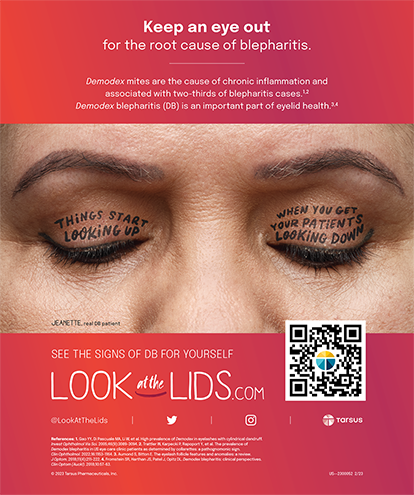Interest in the ocular surface not only from our Main Street patients but also from Wall Street investors continues to grow. A healthy ocular surface has become essential: baby boomers desire perpetual clarity of vision, most everyone’s vocation entails staring at a computer all day, adolescents are incessantly on some sort of an “i” device, and our refractive surgery patients complain of dry eye disease. Topical Restasis (cyclosporine A 0.05%; Allergan, Inc.) makes nearly $1 billion in domestic sales a year—another sign that a focus on ocular surface disease (OSD) is here to stay. Walking the halls at the Association of Research and Vision in Ophthalmology meeting or listening to the whispers at the Ophthalmology Innovation Summit, we can sense that the ocular surface represents an untapped “large-cap” fund.
The myriad symptoms patients present with are representative of OSD. These include foreign body sensation, tearing, burning, and even fluctuating or blurry vision. As ophthalmologists, we are obligated to offer patients therapeutics beyond placebo as well as diagnostics to confirm the presence of causative inflammation. At my northern New Jersey practice, I have set up a Center for Ocular Surface Excellence (COSE-NJ) to identify and treat patients who suffer from OSD via standard and innovative clinical algorithms, including research protocols. My practice’s internal surveys reveal that up to 60% of my patients either have a diagnosis of some form of OSD or have symptoms. It is incumbent on us to care for these patients’ needs. As the middle class burgeons across the world, and as more people gain earlier access to health care, we ophthalmologists are being overwhelmed with patients who have OSD symptoms.
For the past several years, my office has participated in trials that focus on the signs and symptoms of blepharitis, dry eye disease, and ocular allergy. These three entities compose the bulk of OSD with significant overlap. Given the overall decline in traditional cataract surgery reimbursement, many of us are relying on ancillary sources of practice revenue. In this regard, the advent of new diagnostic tests and therapeutics for detecting, diagnosing, and treating OSD could not come at a better time.
Although we should not give up on the traditional tests used to confirm OSD and dysfunctional tear syndrome, particularly Schirmer testing, tear breakup time, tear meniscus levels, and corneal staining patterns, newer tests—some just recently approved by the FDA—are very exciting. These include tear osmolarity analysis (TearLab Osmolarity System; TearLab Corporation), lipid layer interferometry (LipiView Ocular Surface Interferometer; TearScience, Inc.), ocular allergy testing (Doctor’s Allergy Formula), the early detection of Sjögren syndrome (Sjö; Nicox), and the detection of matrix metalloproteinase 9 in tears (InflammaDry; Rapid Pathogen Screening, Inc.). As more practices adopt these tests, future research protocols will incorporate them as part of overall clinical examination parameters or potential endpoints. For diagnosing OSD, matching patients’ profiles via signs and symptoms, corroborating them with a battery of tests, and then applying therapeutics are the wave of the future.
On the therapeutic side, some new drugs are currently in different phases of development. These include lifitegrast (Shire PLC), an integrin antagonist; EBI-005 (Eleven Biotherapeutics), an interleukin-1 signaling inhibitor; and MIM-D3 (Mimetogen Pharmaceuticals; recently optioned to Bausch + Lomb/Valeant Pharmaceuticals), a tyrosine kinase receptor agonist.
As a surgeon, clinician, academician, and researcher, I embrace the innovations involving the ocular surface, both in the realms of diagnostics and therapeutics, as they will have an impact on patients and ultimately enhance the doctor-patient relationship.
Jai G. Parekh, MD, MBA, is the managing partner at Brar-Parekh Eye Associates in Woodland Park, New Jersey, and chief of cornea and external diseases/chief of the Research Institute at St. Joseph’s HealthCare System, located in Wayne/Paterson, New Jersey. Dr. Parekh is also a clinical associate professor of ophthalmology on the Cornea Service at the New York Eye & Ear Infirmary in New York City. Over the past 2 years, he has participated as a consultant, advisor, researcher, and/or speaker for Allergan, Inc., Bausch + Lomb, Doctor’s Allergy Formula, NicOx SA, TearLab Corporation, Rapid Pathogen Screening, Inc., and Shire PLC. Dr. Parekh may be reached at (973) 785-2050; kerajai@gmail.com.


